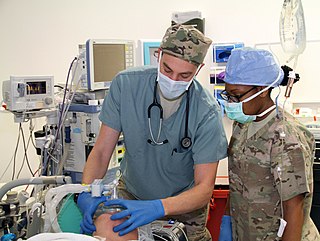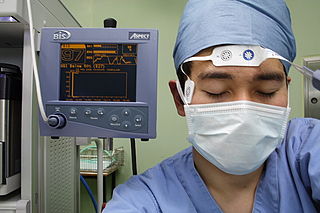Related Research Articles

Anesthesia or anaesthesia is a state of controlled, temporary loss of sensation or awareness that is induced for medical or veterinary purposes. It may include some or all of analgesia, paralysis, amnesia, and unconsciousness. An individual under the effects of anesthetic drugs is referred to as being anesthetized.

Tracheal intubation, usually simply referred to as intubation, is the placement of a flexible plastic tube into the trachea (windpipe) to maintain an open airway or to serve as a conduit through which to administer certain drugs. It is frequently performed in critically injured, ill, or anesthetized patients to facilitate ventilation of the lungs, including mechanical ventilation, and to prevent the possibility of asphyxiation or airway obstruction.

A local anesthetic (LA) is a medication that causes absence of all sensation in a specific body part without loss of consciousness, as opposed to a general anesthetic, which eliminates all sensation in the entire body and causes unconsciousness. Local anesthetics are most commonly used to eliminate pain during or after surgery. When it is used on specific nerve pathways, paralysis also can be induced.

General anaesthesia (UK) or general anesthesia (US) is a method of medically inducing loss of consciousness that renders a patient unarousable even with painful stimuli. This effect is achieved by administering either intravenous or inhalational general anaesthetic medications, which often act in combination with an analgesic and neuromuscular blocking agent. Spontaneous ventilation is often inadequate during the procedure and intervention is often necessary to protect the airway. General anaesthesia is generally performed in an operating theater to allow surgical procedures that would otherwise be intolerably painful for a patient, or in an intensive care unit or emergency department to facilitate endotracheal intubation and mechanical ventilation in critically ill patients. Depending on the procedure, general anaesthesia may be optional or required. Regardless of whether a patient may prefer to be unconscious or not, certain pain stimuli could result in involuntary responses from the patient that may make an operation extremely difficult. Thus, for many procedures, general anaesthesia is required from a practical perspective.

Anesthesiology, anaesthesiology, or anaesthesia is the medical specialty concerned with the total perioperative care of patients before, during and after surgery. It encompasses anesthesia, intensive care medicine, critical emergency medicine, and pain medicine. A physician specialized in anesthesiology is called an anesthesiologist, anaesthesiologist, or anaesthetist, depending on the country. In some countries, the terms are synonymous, while in other countries, they refer to different positions and anesthetist is only used for non-physicians, such as nurse anesthetists.

Spinal anaesthesia, also called spinal block, subarachnoid block, intradural block and intrathecal block, is a form of neuraxial regional anaesthesia involving the injection of a local anaesthetic or opioid into the subarachnoid space, generally through a fine needle, usually 9 cm (3.5 in) long. It is a safe and effective form of anesthesia usually performed by anesthesiologists that can be used as an alternative to general anesthesia commonly in surgeries involving the lower extremities and surgeries below the umbilicus. The local anesthetic with or without an opioid injected into the cerebrospinal fluid provides locoregional anaesthesia: true analgesia, motor, sensory and autonomic (sympathetic) blockade. Administering analgesics in the cerebrospinal fluid without a local anaesthetic produces locoregional analgesia: markedly reduced pain sensation, some autonomic blockade, but no sensory or motor block. Locoregional analgesia, due to mainly the absence of motor and sympathetic block may be preferred over locoregional anaesthesia in some postoperative care settings. The tip of the spinal needle has a point or small bevel. Recently, pencil point needles have been made available.
Awareness under anesthesia, also referred to as intraoperative awareness or accidental awareness during general anesthesia (AAGA), is a rare complication of general anesthesia where patients regain varying levels of consciousness during their surgical procedures. While anesthesia awareness is possible without resulting in any long-term memory of the experience, it is also possible for victims to have awareness with explicit recall, where they can remember the events related to their surgery.

Bispectral index (BIS) is one of several technologies used to monitor depth of anesthesia. BIS monitors are used to supplement Guedel's classification system for determining depth of anesthesia. Titrating anesthetic agents to a specific bispectral index during general anesthesia in adults allows the anesthetist to adjust the amount of anesthetic agent to the needs of the patient, possibly resulting in a more rapid emergence from anesthesia. Use of the BIS monitor could reduce the incidence of intraoperative awareness during anaesthesia. The exact details of the algorithm used to create the BIS index have not been disclosed by the company that developed it.
Perioperative mortality has been defined as any death, regardless of cause, occurring within 30 days after surgery in or out of the hospital. Globally, 4.2 million people are estimated to die within 30 days of surgery each year. An important consideration in the decision to perform any surgical procedure is to weigh the benefits against the risks. Anesthesiologists and surgeons employ various methods in assessing whether a patient is in optimal condition from a medical standpoint prior to undertaking surgery, and various statistical tools are available. ASA score is the most well known of these.
Minimum alveolar concentration or MAC is the concentration, often expressed as a percentage by volume, of a vapour in the alveoli of the lungs that is needed to prevent movement in 50% of subjects in response to surgical (pain) stimulus. MAC is used to compare the strengths, or potency, of anaesthetic vapours. The concept of MAC was first introduced in 1965.
Postoperative cognitive dysfunction (POCD) is a decline in cognitive function that may last from 1–12 months after surgery, or longer. In some cases, this disorder may persist for several years after major surgery. POCD is distinct from emergence delirium. Its causes are under investigation and occurs commonly in older patients and those with pre-existing cognitive impairment.
In the United States, anesthesia can be administered by physician anesthesiologists, an anesthesiologist assistant, or nurse anesthetist.
Cardiothoracic anesthesiology is a subspeciality of the medical practice of anesthesiology, devoted to the preoperative, intraoperative, and postoperative care of adult and pediatric patients undergoing cardiothoracic surgery and related invasive procedures.
Geriatric anesthesia is the branch of medicine that studies anesthesia approach in elderly.
Continuous wound infiltration (CWI) refers to the continuous infiltration of a local anesthetic into a surgical wound to aid in pain management during post-operative recovery.

Throughout recorded history, attempts at producing a state of general anesthesia can be traced back to the writings of ancient Sumerians, Babylonians, Assyrians, Egyptians, Indians, and Chinese. Despite significant advances in anatomy and surgical technique during the Renaissance, surgery remained a last-resort treatment largely due to the pain associated with it. However, scientific discoveries in the late 18th and early 19th centuries paved the way for the development of modern anesthetic techniques.
Certified anesthesiologist assistants (CAAs) are highly trained master’s degree level non-physician anesthesia care providers. CAAs are integral members of the anesthesia care team as described by the American Society of Anesthesiologists (ASA). This designation must be disambiguated from the Certified Clinical Anesthesia Assistant (CCAA) designation conferred by the Canadian Society of Respiratory Therapists. All CAAs possess a baccalaureate degree, and complete an intensive didactic and clinical program at a postgraduate level. CAAs are trained in the delivery and maintenance of all types of anesthesia care as well as advanced patient monitoring techniques. The goal of CAA education is to guide the transformation of student applicants into competent clinicians.
The following outline is provided as an overview of and topical guide to anesthesia:
Obstetric anesthesia or obstetric anesthesiology, also known as ob-gyn anesthesia or ob-gyn anesthesiology, is a sub-specialty of anesthesiology that provides peripartum pain relief (analgesia) for labor and anesthesia for cesarean deliveries ('C-sections').
Alex Macario is an American anesthesiologist, academic and author. He is a vice-chair for education, a professor in the Department of Anesthesiology, Perioperative and Pain Medicine, and program director for the anesthesiology residency at Stanford University School of Medicine.
References
- 1 2 3 Saklad M (1941). "Grading of patients for surgical procedures". Anesthesiology. 2 (3): 281–4. doi:10.1097/00000542-194105000-00004. S2CID 70791633.
- ↑ ASA Relative Value Guide 2002, American Society of Anesthesiologists, page xii, Code 99140.
- ↑ "ASA Physical Status Classification System". American Society of Anesthesiologists. Archived from the original on 2010-10-08. Retrieved 2007-07-09.
- ↑ Fehrenbach, Margaret, ASA Physical Status Classification System for Dental Professionals at http://www.dhed.net/ASA_Physical_Status_Classification_SYSTEM.html
- 1 2 Little JP (1995). "Consistency of ASA grading". Anaesthesia. 50 (7): 658–9. doi: 10.1111/j.1365-2044.1995.tb15125.x . PMID 7653772.
- ↑ Haynes SR, Lawler PG (1995). "An assessment of the consistency of ASA physical status classification allocation". Anaesthesia. 50 (3): 195–9. doi: 10.1111/j.1365-2044.1995.tb04554.x . PMID 7717481.
- ↑ Owens WD, Felts JA, Spitznagel EL (1978). "ASA physical status classification: A study of consistency of ratings". Anesthesiology. 49 (4): 239–43. doi: 10.1097/00000542-197810000-00003 . PMID 697077. S2CID 36142823.
- ↑ Harling DW (July 1995). "Consistency of ASA Grading". Anaesthesia. 50 (7): 659. doi: 10.1111/j.1365-2044.1995.tb15125.x . PMID 7653773.
- ↑ Pratt, Stephen D. "Clinical Forum Revisited: The "P" Value" (PDF). Spring 2003 newsletter. The Society for Obstetric Anesthesia and Perinatology (SOAP). pp. 9–11. Archived from the original (PDF) on May 9, 2008. Retrieved 2007-07-09.
- ↑ Owens William D (2001). "American Society of Anesthesiologists Physical Status Classification System Is Not a Risk Classification System". Anesthesiology. 94 (2): 378. doi: 10.1097/00000542-200102000-00042 . PMID 11176115.
- 1 2 Lema, Mark J (September 2002). "Using the ASA Physical Status Classification May Be Risky Business". ASA Newsletter. American Society of Anesthesiologists. 66 (9). Archived from the original on 10 July 2007. Retrieved 2007-07-09.
- ↑ Spell, Nathan O.; Lubin, Michael F.; Smith, Robert Metcalf; Dodson, Thomas F. (2006). Medical Management of the Surgical Patient: A Textbook of Perioperative Medicine. Cambridge, UK: Cambridge University Press. ISBN 0-521-82800-7.
- 1 2 Segal, Scott. "Women Presenting in Labor Should be Classified as ASA E: Pro". Winter 2003 newsletter. SOAP. Archived from the original on 26 June 2007. Retrieved 2007-07-09.
- ↑ CULLEN SC (1963). "New classification of physical status". Anesthesiology. 24: 110–1. doi:10.1097/00000542-196301000-00018. PMID 14024198.